Ratiometric Dissolved Oxygen Sensors Based on Ruthenium Complex Doped with Silver Nanoparticles
Abstract
:1. Introduction
2. Experimental
2.1. Chemical and Materials
2.2. Synthesis of Silver Nanoparticles
2.3. Sensor Fabrication
2.4. Experiment Setup
3. Results and Discussion
3.1. Structure and Morphology of the Sensors
3.2. Calibration of the Oxygen Sensor Film
3.3. Oxygen Sensitivity and Accuracy Evaluation
3.4. Characteristics of Detection and Resolution
3.5. Long Term Stability
3.6. Effect of pH and Metal Ions
3.7. Response Time of Ru(DPP)3Cl2
3.8. Photostability
4. Application of the Optical Sensors for Oxygen Measurements of Chlorella Vulgaris
4.1. Chlorella Vulgaris Samples
4.2. Imaging of the Two-Dimensional O2 Distribution for Chlorella vulgaris
5. Conclusions
Author Contributions
Conflicts of Interest
References
- Wang, X.D.; Wolfbeis, O.S. Optical methods for sensing and imaging oxygen: Materials, spectroscopies and applications. Chem. Soc. Rev. 2014, 43, 3666–3761. [Google Scholar] [CrossRef] [PubMed]
- Bowen, E.J.; Norton, A. The quenching of fluorescence in solution. Trans. Faraday Soc. 1939, 35, 44–48. [Google Scholar] [CrossRef]
- Ishiji, T.; Kaneko, M. Photoluminescence of pyrenebutyric acid incorporated into silicone film as a technique in luminescent oxygen sensing. Analyst 1995, 120, 1633–1638. [Google Scholar] [CrossRef]
- Borisov, S.M.; Mayr, T.; Mistlberger, G.; Waich, K.; Koren, K.; Chojnacki, P.; Klimant, I. Precipitation as a simple and versatile method for preparation of optical nanochemosensors. Talanta 2009, 79, 1322–1330. [Google Scholar] [CrossRef] [PubMed]
- Toro, M.M.; Fernandez-Sanchez, J.F.; Baranoff, E.; Nazeeruddin, M.K.; Graetzel, M.; Fernandez-Gutierrez, A. Novel luminescent Ir(III) dyes for developing highly sensitive oxygen sensing films. Talanta 2010, 82, 620–626. [Google Scholar] [CrossRef] [PubMed]
- Xu, W.Y.; Kneas, K.A.; Demas, J.N.; DeGraff, B.A. Oxygen sensors based on luminescence quenching of metal complexes: Osmium complexes suitable for laser diode excitation. Anal. Chem. 1996, 68, 2605–2609. [Google Scholar] [CrossRef] [PubMed]
- Hirao, T.; Fukuhara, S. An organic catalytic system for dehydrogenative oxidation. J. Org. Chem. 1998, 63, 7534–7535. [Google Scholar] [CrossRef] [PubMed]
- Sacksteder, L.; Demas, J.N.; DeGraff, B.A. Design of oxygen sensors based on quenching of luminescent metal complexes: Effect of ligand size on heterogeneity. Anal. Chem. 1993, 65, 3480–3483. [Google Scholar] [CrossRef]
- Roche, P.J.R.; Cheung, M.C.K.; Yung, K.Y.; Kirk, A.G.; Chodavarpu, V.P.; Bright, F.V. Application of gold quenching of luminescence to improve oxygen sensing using a ruthenium (4,7-diphenyl-1,10-phenanthroline)3Cl2:TEOS thin film. Sens. Actuators B Chem. 2010, 147, 581–586. [Google Scholar] [CrossRef]
- Estella, J.; Wencel, D.; Moore, J.P.; Sourdaine, M.; McDonagh, C. Fabrication and performance evaluation of highly sensitive hybrid sol–gel-derived oxygen sensor films based on a fluorinated precursor. Anal. Chim. Acta 2010, 666, 83–90. [Google Scholar] [CrossRef] [PubMed]
- Lupo, F.; Fragalà, M.E.; Gupta, T.; Mamo, A.; Aureliano, A.; Bettinelli, M.; Speghini, A.; Gulino, A. Luminescence of a ruthenium complex monolayer, covalently assembled on silica substrates, upon CO exposure. J. Phys. Chem. C 2010, 114, 13459–13464. [Google Scholar] [CrossRef]
- Wu, X.; Song, L.; Li, B.; Liu, Y. Synthesis, characterization, and oxygen sensing properties of Ru(II) complex covalently grafted to mesoporous MCM-41. J. Lumin. 2010, 130, 374–379. [Google Scholar] [CrossRef]
- Zhang, H.; Lei, B.; Mai, W.; Liu, Y. Oxygen-sensing materials based on ruthenium(II) complex covalently assembled mesoporous MSU-3 silica. Sens. Actuators B Chem. 2011, 160, 677–683. [Google Scholar] [CrossRef]
- Wang, B.; Liu, Y.; Li, B.; Yue, S.; Li, W. Optical oxygen sensing materials based on trinuclear starburst ruthenium(II) complexes assembled in mesoporous silica. J. Lumin. 2008, 128, 341–347. [Google Scholar] [CrossRef]
- Zhang, H.; Li, B.; Lei, B.; Li, W. Oxygen-sensing materials based on [Ru(bpy)3]2+ covalently grafted MSU-3 mesoporous molecular sieves. J. Lumin. 2008, 128, 1331–1338. [Google Scholar] [CrossRef]
- Cywinski, P.J.; Moro, A.J.; Stanca, S.E.; Biskup, C.; Mohr, G.J. Ratiometric porphyrin-based layers and nanoparticles for measuring oxygen in biosamples. Sens. Actuators B Chem. 2009, 135, 472–477. [Google Scholar] [CrossRef]
- Wu, W.; Wu, W.; Ji, S.; Guo, H.; Song, P.; Han, K.; Chi, L.; Shao, J.; Zhao, J. Tuning the emission properties of cyclometalated platinum(II) complexes by intramolecular electron-sink/arylethynylated ligands and its application for enhanced luminescent oxygen sensing. J. Mater. Chem. 2010, 20, 9775–9786. [Google Scholar] [CrossRef]
- Gulino, A.; Giuffrida, S.; Mineo, P.; Purrazzo, M.; Scamporrino, E.; Ventimiglia, G.; van der Boom, M.E.; Fragalà, I. Photoluminescence of a covalent assembled porphyrin-based monolayer: Optical behavior in the presence of O2. J. Phys. Chem. B 2006, 110, 16781–16786. [Google Scholar] [CrossRef] [PubMed]
- Gulino, A.; Bazzano, S.; Condorelli, G.G.; Giuffrida, S.; Mineo, P.; Satriano, C.; Scamporrino, E.; Ventimiglia, G.; Vitalini, D.; Fragalà, I. Engineered Silica Surfaces with an Assembled C60 Fullerene Monolayer. Chem. Mater. 2005, 17, 1079–1084. [Google Scholar] [CrossRef]
- Wang, X.; Peng, H.; Ding, H.; You, F.; Huang, S.; Teng, F.; Dong, B.; Song, H. Biocompatible fluorescent core-shell nanoparticles for ratiometric oxygen sensing. J. Mater. Chem. 2012, 22, 16066–16071. [Google Scholar] [CrossRef]
- Wang, X.; Peng, H.; Chang, Z.; Hou, L.; You, F.; Teng, F.; Song, H.; Dong, B. Synthesis of ratiometric fluorescent nanoparticles for sensing oxygen. Microchim. Acta 2012, 178, 147–152. [Google Scholar] [CrossRef]
- Chatni, M.R.; Maier, D.E.; Porterfield, D.M. Evaluation of microparticle materials for enhancing the performance of fluorescence lifetime based optrodes. Sens. Actuators B Chem. 2009, 141, 471–477. [Google Scholar] [CrossRef]
- Ongun, M.Z.; Oter, O.; Sabanci, G.; Ertekin, K.; Celik, E. Enhanced stability of ruthenium complex in ionic liquid doped electrospun fibers. Sens. Actuators B Chem. 2013, 183, 11–19. [Google Scholar] [CrossRef]
- Fercher, A.; Borisov, S.M.; Zhdanov, A.V.; Klimant, I.; Papkovsky, D.B. Intracellular O2 sensing probe based on cell-penetrating phosphorescent nanoparticles. ACS Nano 2011, 5, 5499–5508. [Google Scholar] [CrossRef] [PubMed]
- McDonagh, C.; Bowe, P.; Mongey, K.; MacCraith, B.D. Characterisation of porosity and sensor response times of sol–gel-derived thin films for oxygen sensor applications. J. Non Cryst. Solids 2002, 306, 138–148. [Google Scholar] [CrossRef]
- Xiong, Y.; Zhu, D.; Chen, S.; Peng, H.; Guan, Y. A Fiber-optic evanescent wave O2 sensor based on Ru(II)-doped fluorinated ORMOSILs. J. Fluoresc. 2010, 20, 269–274. [Google Scholar] [CrossRef] [PubMed]
- Glud, R.N.; Ramsing, N.B.; Gundersen, J.K.; Klimant, I. Planar optrodes: A new tool for fine scale measurements of two-dimensional O2 distribution in benthic communities. Mar. Ecol. Prog. Ser. 1996, 140, 217–226. [Google Scholar] [CrossRef]
- Holst, G.; Grunwald, B. Luminescence lifetime imaging with transparent oxygen optodes. Sens. Actuators B Chem. 2001, 74, 78–90. [Google Scholar] [CrossRef]
- Larsen, M.; Borisov, S.M.; Grunwald, B.; Klimant, I.; Glud, R.N. A simple and inexpensive high resolution color ratiometric planar optode imaging approach: Application to oxygen and pH sensing. Limnol. Oceanogr. Meth. 2011, 9, 348–360. [Google Scholar] [CrossRef]
- Zang, L.; Zhao, H.; Hua, J.; Qin, F.; Zheng, Y.; Zhang, Z.; Cao, W. Ratiometric dissolved oxygen sensitive indicator based on lutetium labeled hematoporphyrin monomethyl ether with balanced phosphorescence and fluorescence dual emission. Sens. Actuators B Chem. 2016, 231, 539–546. [Google Scholar] [CrossRef]
- Lee, S.; Jin, S. Method for the measurement of dissolved oxygen in a cell culture microchannel using oxygen-sensitive luminescence. Trans. Korean Soc. Mech. Eng. B 2012, 36, 533–538. [Google Scholar] [CrossRef]
- Gryczynski, I.; Malicka, J.; Holder, E.; DiCesare, N.; Lakowicz, J.R. Effects of metallic silver particles on the emission properties of [Ru(bpy)3]2+. Chem. Phys. Lett. 2003, 372, 409–414. [Google Scholar] [CrossRef]
- Kandimalla, V.K. Influence of Metal Nanoparticles on Fluorescence Properties. Master’s Theses, Eastern Michigan University, Ypsilanti, MI, USA, 2010. [Google Scholar]
- Ozturk, O.; Oter, O.; Yildirim, S.; Subasi, E.; Ertekin, K.; Celik, E.; Temel, H. Tuning oxygen sensitivity of ruthenium complex exploiting silver nanoparticles. J. Lumin. 2014, 155, 191–197. [Google Scholar] [CrossRef]
- Xiao-li, X.; Tang, Y.; Zheng, B. Dissolved oxygen sensor based on sol–gel matrix doped with tris(2,2′-bipyridine)ruthenium dichloride. J. Chongqing Univ. 2013, 1, 11–15. [Google Scholar]
- Lee, P.C.; Meisel, D. Adsorption and surface-enhanced Raman of dyes on silver and gold sols. J. Phys. Chem. 1982, 86, 3391–3395. [Google Scholar] [CrossRef]
- Stern, O.; Volmer, M. Über die abklingzeit der fluoreszenz. Phys. Z. 1919, 20, 183–188. (In Germany) [Google Scholar]
- Papkovsky, D.B. New oxygen sensors and their application to biosensing. Sens. Actuators B Chem. 1995, 29, 213–218. [Google Scholar] [CrossRef]
- Bacon, J.R.; Demas, J.N. Determination of oxygen concentrations by luminescence quenching of a polymer-immobilized transition-metal complex. Anal. Chem. 1987, 59, 2780–2785. [Google Scholar] [CrossRef]
- Jorge, P.A.S.; Mayeh, M.; Benrashid, R.; Caldas, P.; Santos, J.L.; Farahi, F. Applications of quantum dots in optical fiber luminescent oxygen sensors. Appl. Opt. 2006, 45, 3760–3767. [Google Scholar] [CrossRef] [PubMed]
- Xu, H.; Aylott, J.W.; Kopelman, R.; Miller, T.J.; Philbert, M.A. A real-time ratiometric method for the determination of molecular oxygen inside living cells using sol–gel-based spherical optical nanosensors with applications to rat C6 glioma. Anal. Chem. 2001, 73, 4124–4133. [Google Scholar] [CrossRef] [PubMed]
- Cheng, Z.L.; Aspinwall, C.A. Nanometre-sized molecular oxygen sensors prepared from polymer stabilized phospholipid vesicles. Analyst 2006, 131, 236–243. [Google Scholar] [CrossRef] [PubMed]
- Wolfbeis, O.S.; Trettnak, W. Fluorescence quenching of acridinium and 6-methoxyquinolinium ions by Pb2+, Hg2+, Cu2+, Ag+ and hydrogen sulphide. Spectrochim. Acta Part A Mol. Spectrosc. 1987, 43, 405–408. [Google Scholar] [CrossRef]
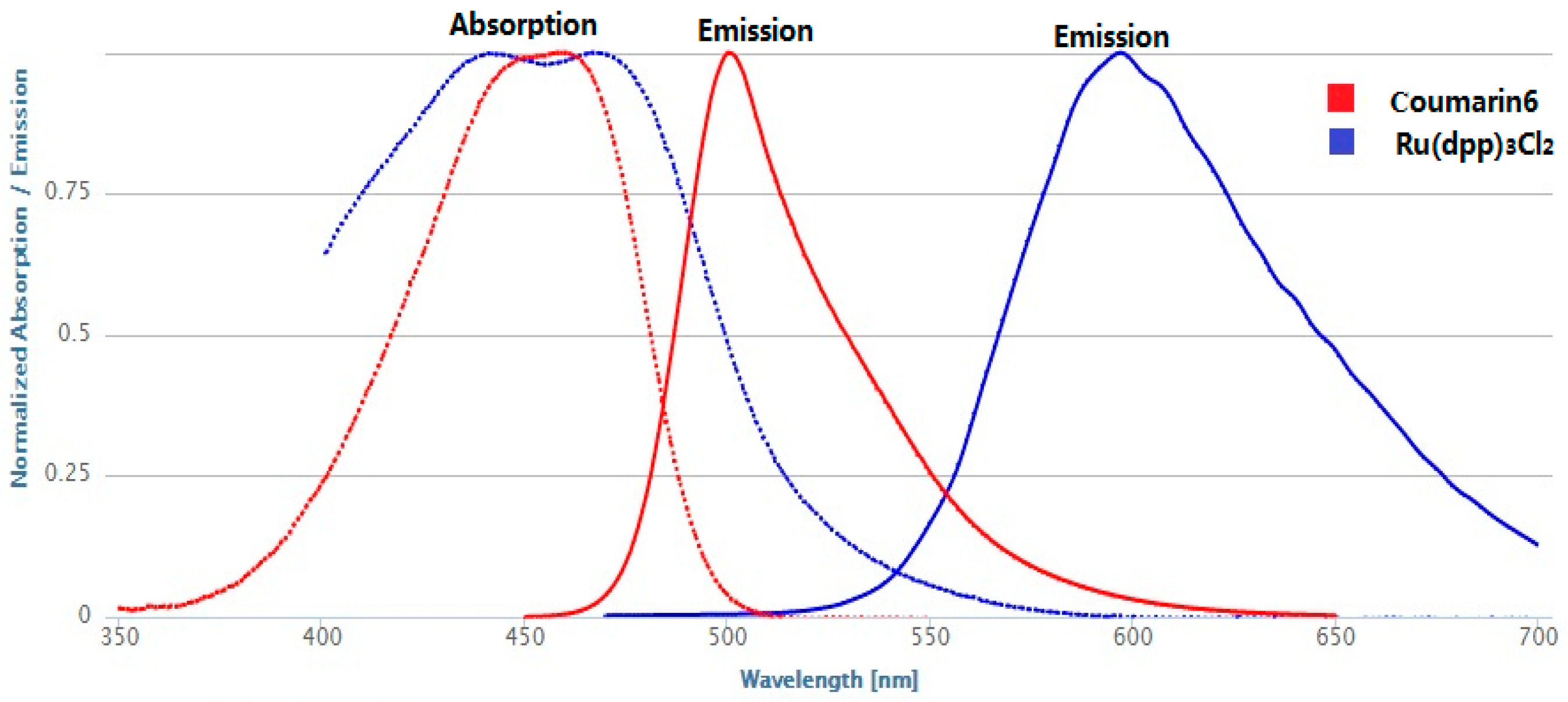
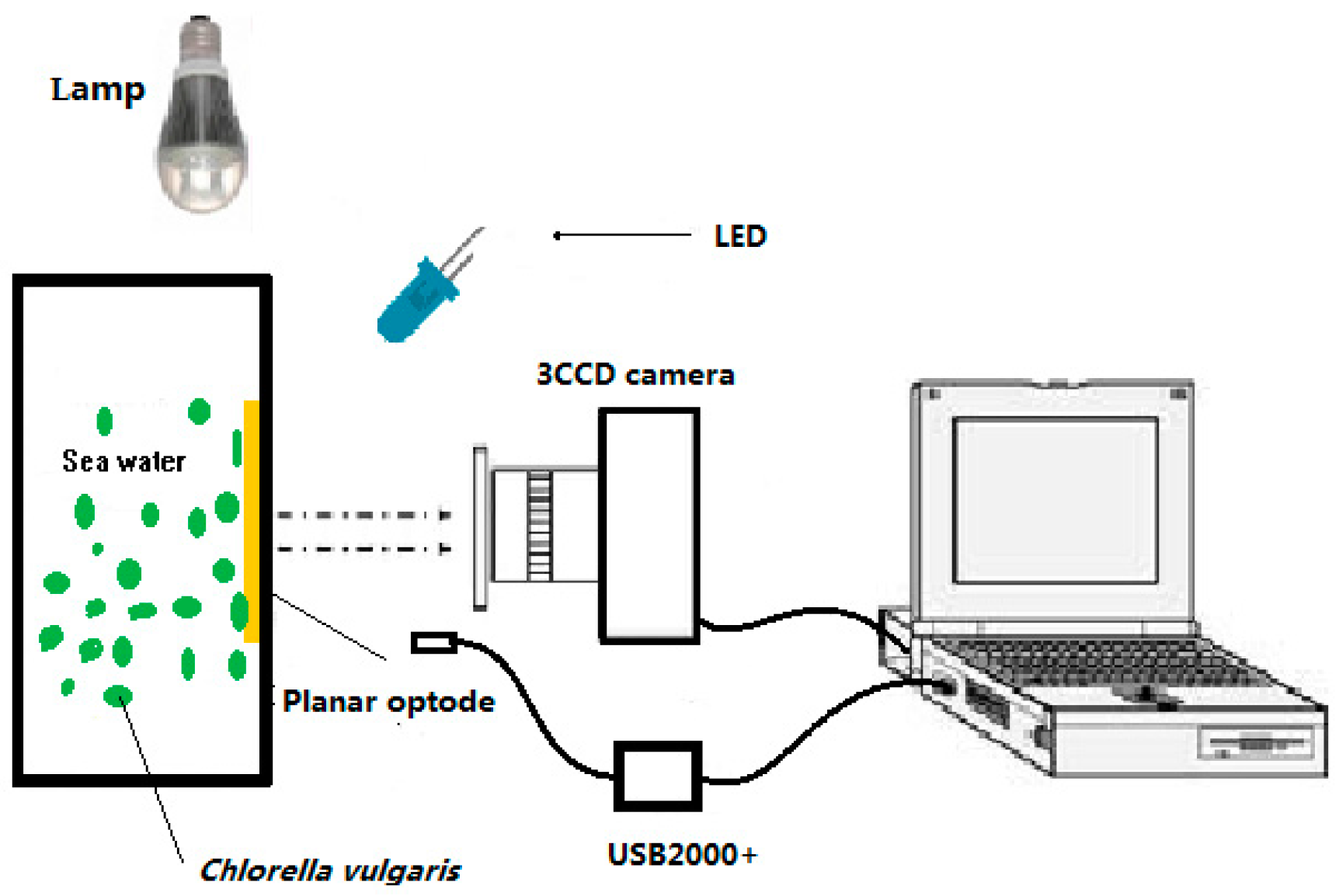
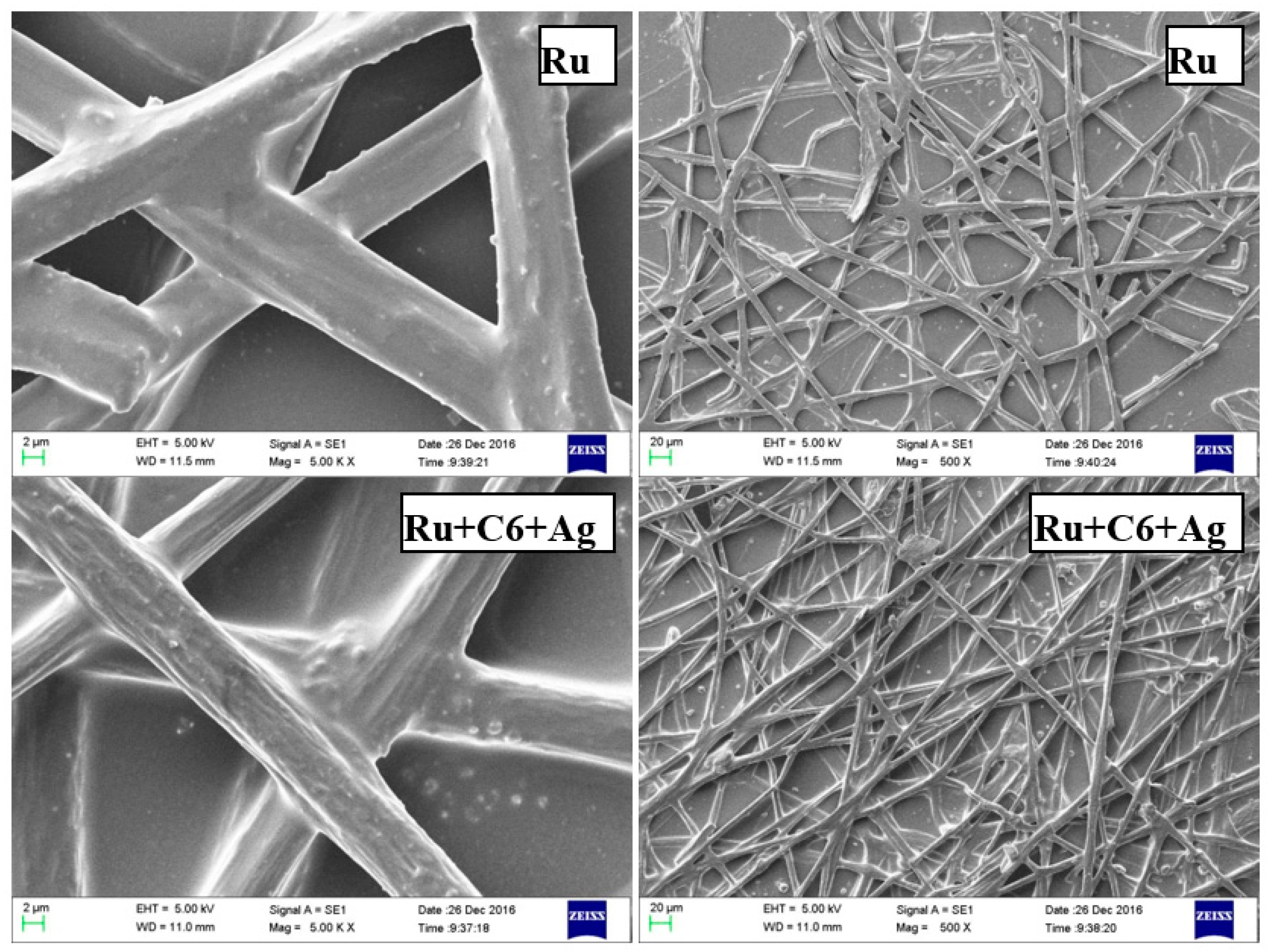

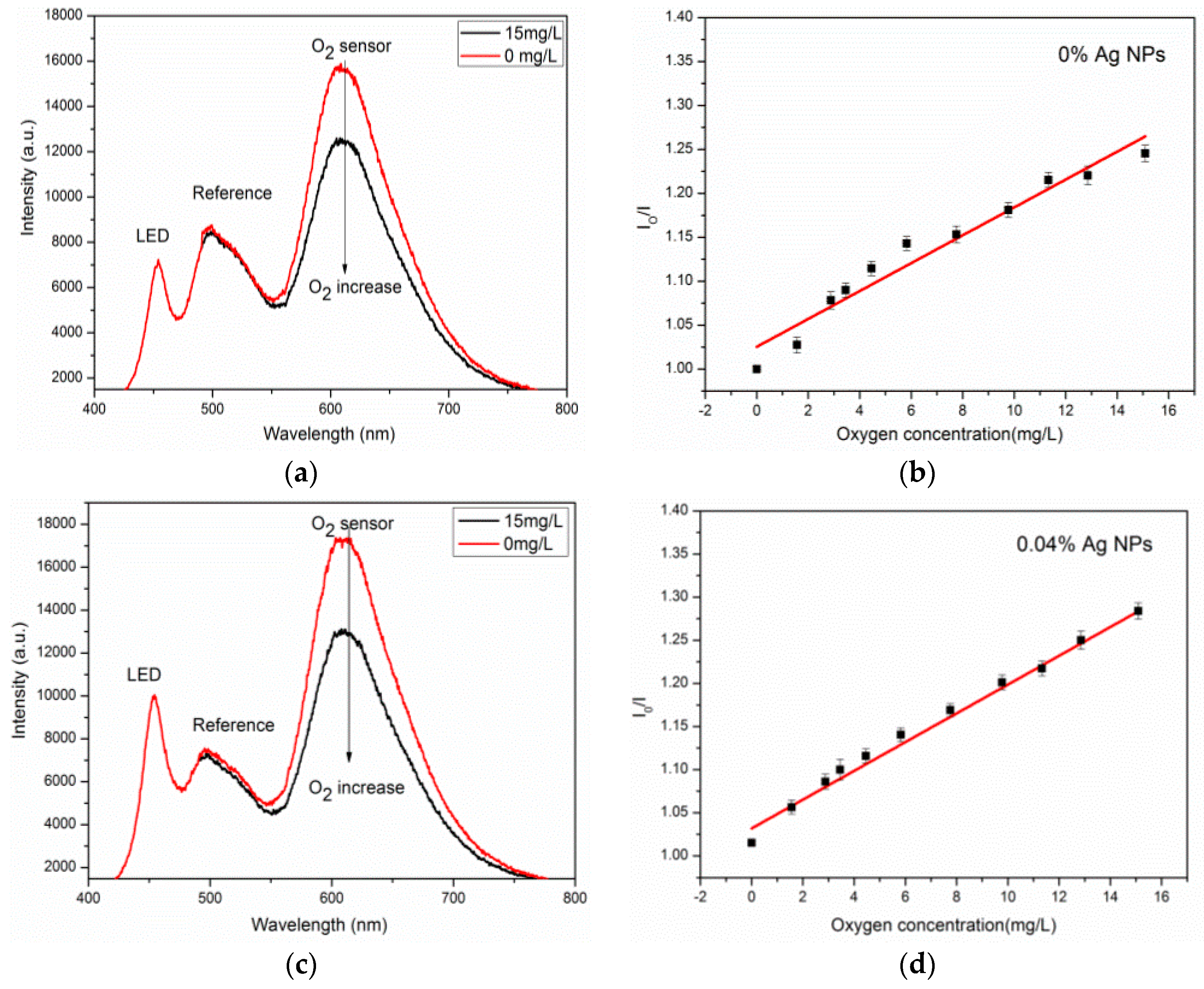


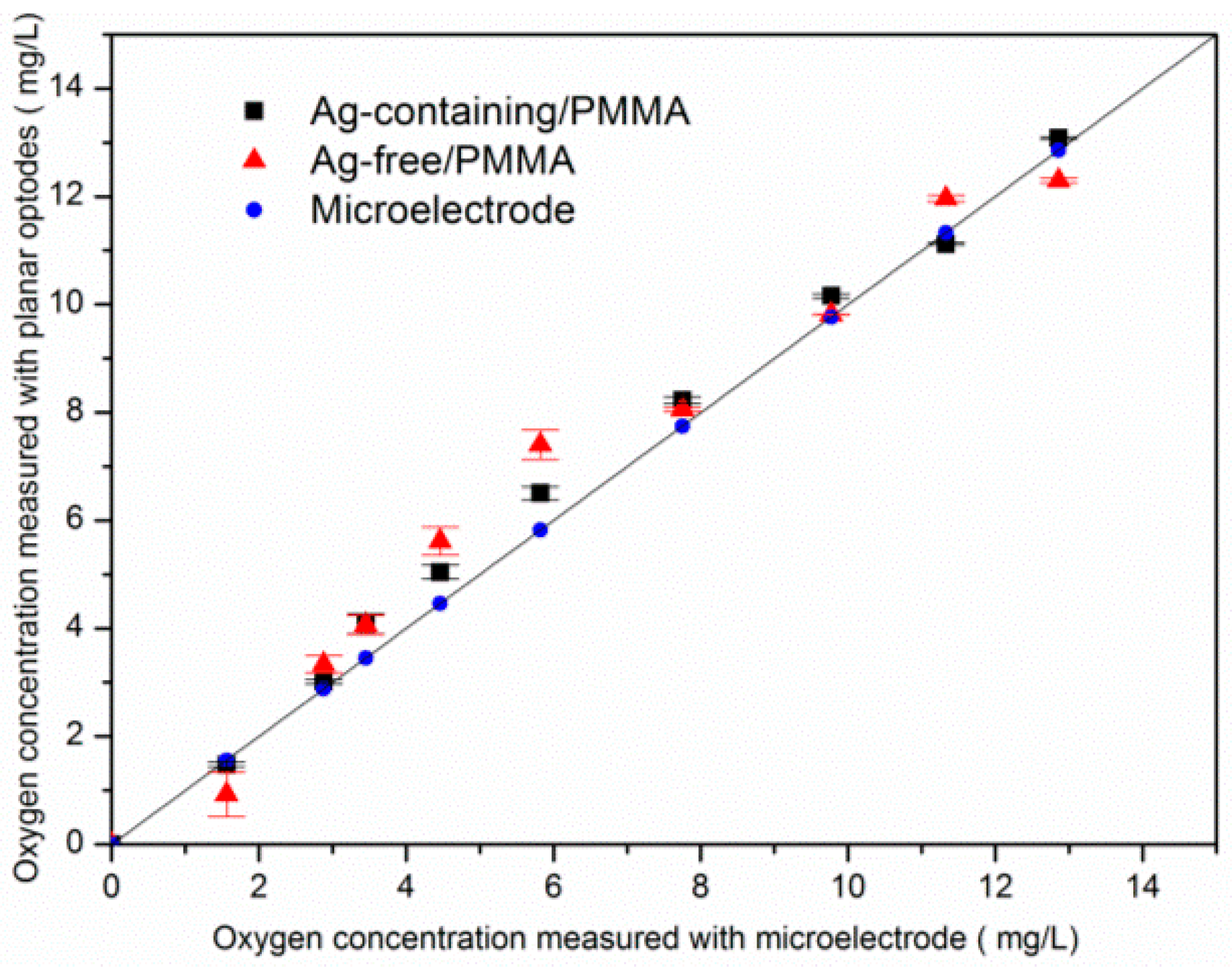

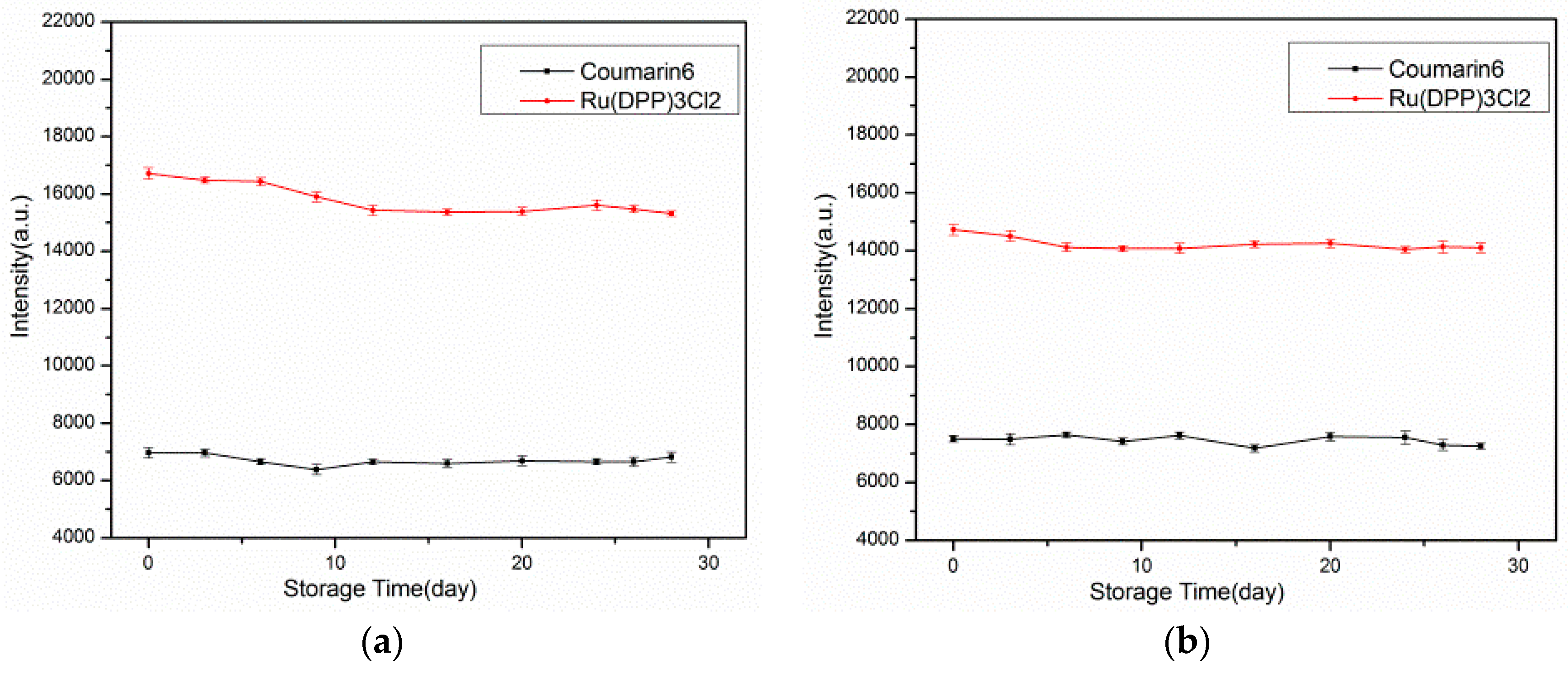


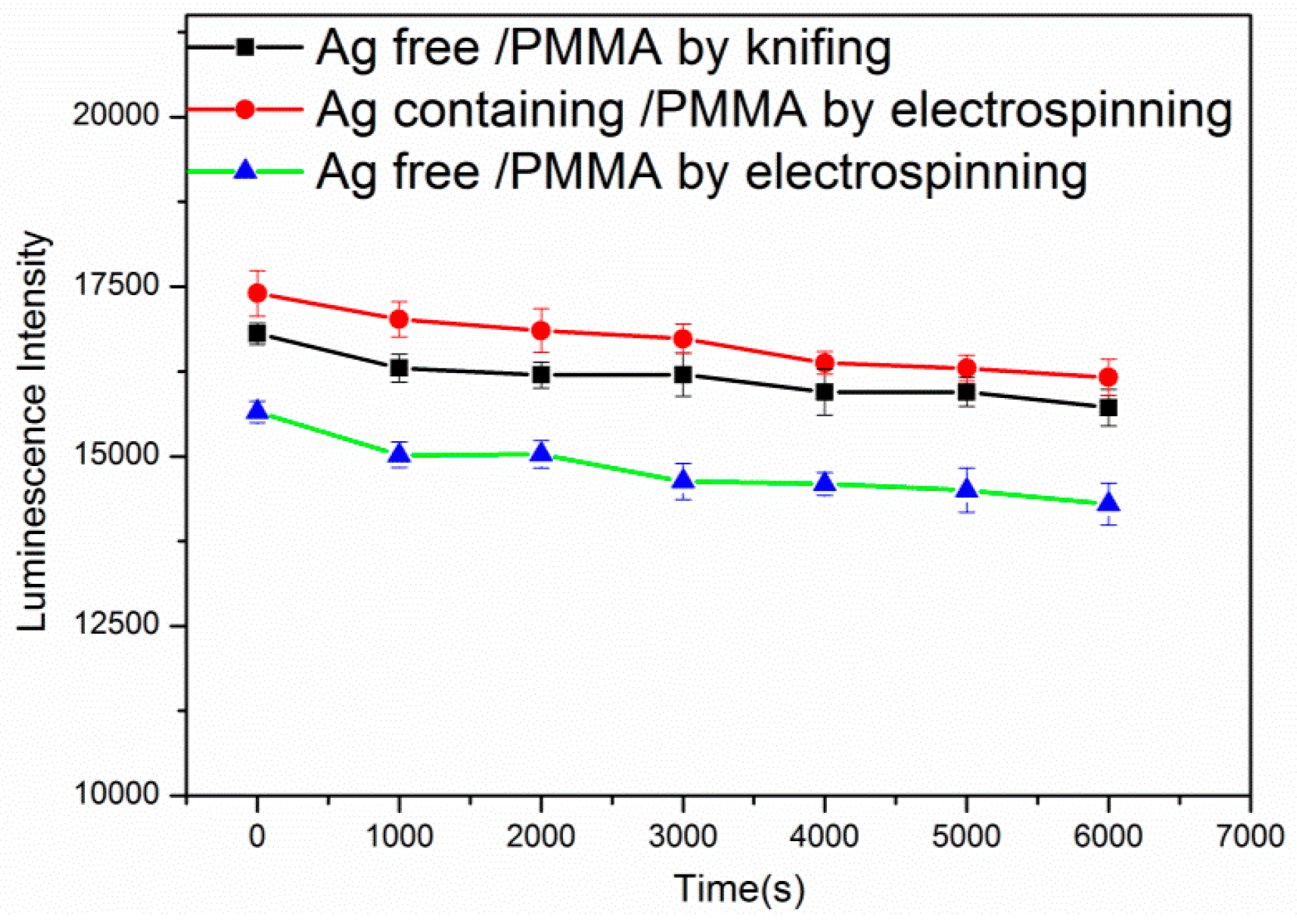

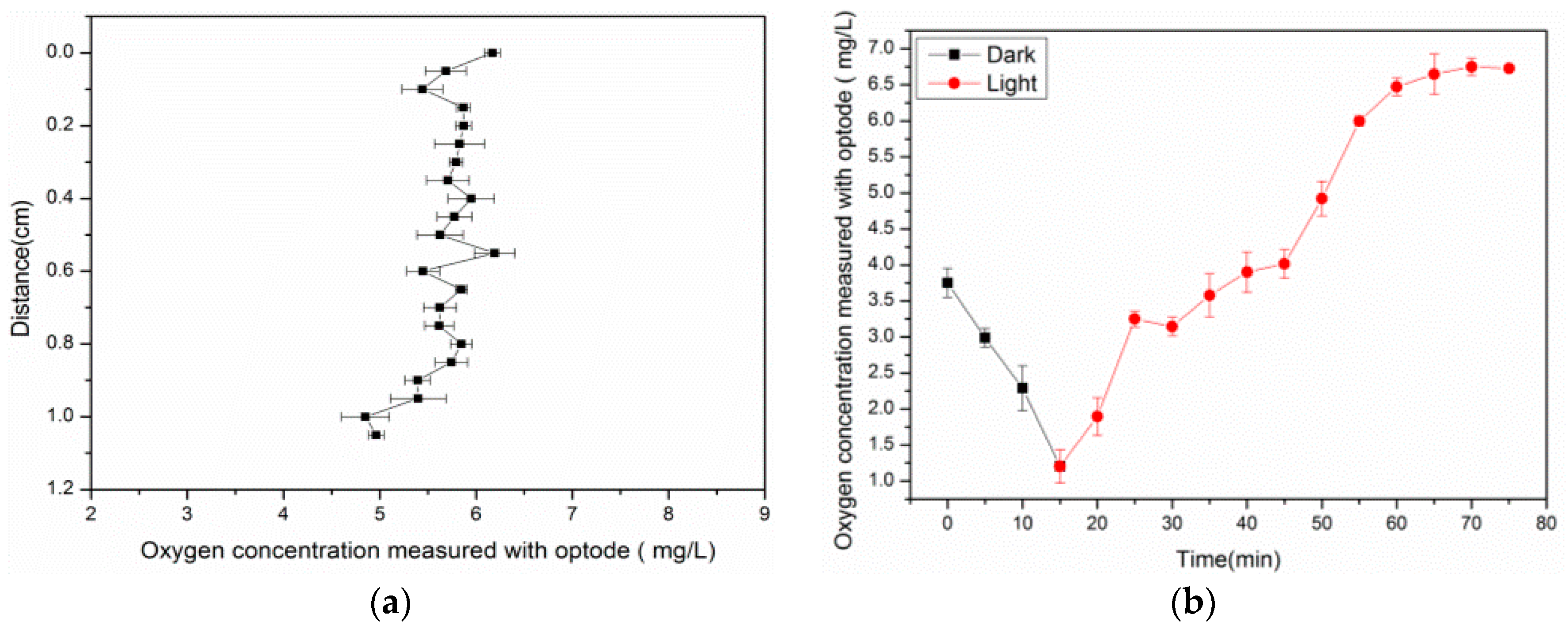
| Film Type | Ksv (mg/L−1) | Standard Error | R2 |
|---|---|---|---|
| Ru(DPP)3Cl2 in PMMA | 0.015 | 0.00114 | 0.9503 |
| Ru(DPP)3Cl2/Ag in PMMA | 0.019 | 0.00072 | 0.9837 |
| Unisense O2 Electrodes | Ru(DPP)3Cl2 | |||
|---|---|---|---|---|
| PMMA/Ag NPs-Free | PMMA/Ag NPs | |||
| Measured | Calculated | RE | Calculated | RE |
| 0 | 0 | 0% | 0 | 0% |
| 2.88 | 3.33 | 15.87% | 3.00 | 4.51% |
| 5.82 | 7.40 | 27.25% | 6.51 | 11.8% |
| 75 | 8.06 | 4.00% | 8.22 | 6.15% |
| 9.77 | 9.81 | 0.48% | 10.16 | 4.00% |
| 11.33 | 11.96 | 5.60% | 11.12 | 1.83% |
| 12.86 | 12.29 | 4.37% | 13.08 | 1.75% |
| Dye/Matrix | Method | Dope | λ exc/em | IR | Comments | Ref. |
|---|---|---|---|---|---|---|
| [Ru(bpy)3]2+ in sol–gel matrix | Intensity | - | 470/680 | ~10.6 | Good linear SVPs only at low oxygen; fast response 5 s, 10 s; no leaching effect; good photostable. | [35] |
| [Ru(bpy)3]2+/Calcein | Ratio | - | 423/515,627 | ~1.8 | Ratiometric sensing method; non-linear SVPs; good antijamming capability. | [31] |
| Ru(bipy)32+ in EC matrix | Intensity | Ag NPs | 460/610 | ~2.0 | Porous structure; good linear SVPs; intensity method; good mechanical strength. | [34] |
| [Ru(bpy)3]2+ + CdSe–ZnS QD in sol–gel matrix | Ratio | - | 470/520,600 | - | Stable self-referenced oxygen sensor; suitable for long term use; independent of fluctuations in excitation; QDs are temperature dependent. | [40] |
| Ru(DPP)3Cl2 + Oregon Green in sol–gel nanoparticles | Ratio | - | 488/610 | ~6 | Particles size 50–300 nm; PEG added as a steric stabilizer; also good for sensing in solution; stable to leaching and decomposition; reference dye Oregon Green is pH sensitive; response time below 1 s. | [41] |
| Ru(phen)3 + NBD-PE in polymerized phospholipid vesicle | Ratio | - | 450/510,600 | ~3 | Chemically-stabilized phospholipid vesicle sensors; general linear response over the entire range of dissolved O2 encountered in biological systems; nanometer-sized; biocompatible chemical sensors. | [42] |
| Ru(DPP)3Cl2 + Coumarin6 in PMMA matrix | Ratio | Ag NPs | 450/498,608 | ~1.5 | Fibrous structure by PMMA; good linear SVPs; ratiometric approach show good antijamming capability; general response 1.0 s, 45 s; good mechanical strength. | This study |
© 2017 by the authors. Licensee MDPI, Basel, Switzerland. This article is an open access article distributed under the terms and conditions of the Creative Commons Attribution (CC BY) license ( http://creativecommons.org/licenses/by/4.0/).
Share and Cite
Jiang, Z.; Yu, X.; Zhai, S.; Hao, Y. Ratiometric Dissolved Oxygen Sensors Based on Ruthenium Complex Doped with Silver Nanoparticles. Sensors 2017, 17, 548. https://doi.org/10.3390/s17030548
Jiang Z, Yu X, Zhai S, Hao Y. Ratiometric Dissolved Oxygen Sensors Based on Ruthenium Complex Doped with Silver Nanoparticles. Sensors. 2017; 17(3):548. https://doi.org/10.3390/s17030548
Chicago/Turabian StyleJiang, Zike, Xinsheng Yu, Shikui Zhai, and Yingyan Hao. 2017. "Ratiometric Dissolved Oxygen Sensors Based on Ruthenium Complex Doped with Silver Nanoparticles" Sensors 17, no. 3: 548. https://doi.org/10.3390/s17030548






